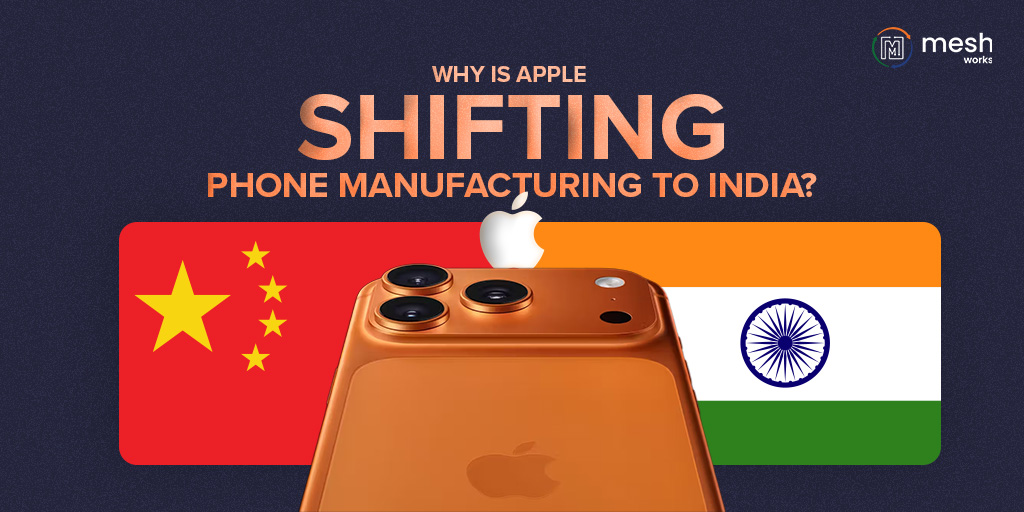For years, Apple’s supply chain has been a symbol of precision, scale, and efficiency — largely made possible by its deep-rooted partnerships in China. But today, Apple is rewriting the playbook.
The company is now aggressively shifting parts of its iPhone production to India — a move that reflects not just a tactical adjustment, but a signal of a larger, more permanent transformation in global manufacturing.
If the world’s most valuable company is rethinking its manufacturing strategy, what does that mean for the rest of us?
A Long-Term Partnership Under Pressure
Apple’s relationship with Chinese manufacturers has been one of the most successful industrial collaborations in modern history. Foxconn, Pegatron, and other contract manufacturers in China have built a near-flawless supply chain capable of producing hundreds of millions of iPhones each year.
But that dependence has also become a liability. Over the past five years, Apple has faced mounting challenges:
Rising labor costs in key Chinese industrial hubs
Geopolitical friction between the U.S. and China, including tech restrictions and tariffs
Severe COVID lockdowns that disrupted operations — most notably the Zhengzhou “iPhone City” shutdown in 2022, which caused major delays during peak production season
These disruptions made it clear: even the best-run supply chain in the world can become a single point of failure.
Why India Is Apple’s Plan B — and Now, Plan A
Apple’s shift to India didn’t happen overnight. Over the past few years, the company has been quietly building a new foundation for its manufacturing operations outside of China.
Here’s why India is emerging as a major iPhone manufacturing hub:
Government Support and Policy Alignment
India’s government has made electronics manufacturing a national priority. Its Production Linked Incentive (PLI) scheme offers billions in incentives to manufacturers who produce in India — and Apple’s suppliers have been among the biggest beneficiaries.
Expanding Supplier Base
Major Apple contractors like Foxconn and Pegatron have opened or expanded Indian facilities. Tata Group — one of India’s largest conglomerates — is now assembling iPhones and recently acquired Wistron’s India operations, deepening the local ecosystem.
Labor and Market Advantages
India offers a young, abundant workforce at lower labor costs than China — alongside a rapidly growing domestic smartphone market. This makes it attractive both as a manufacturing base and an end market.
According to Bloomberg, Apple plans to produce 25% of all iPhones in India by 2025 — up from just 5-7% in 2022.
A Global Shift: From “Made in China” to “Made in Many Places”
Apple isn’t abandoning China. But it is making a deliberate move toward supply chain diversification — a trend that’s accelerating across the tech and manufacturing landscape.
This is the “China + 1” strategy in action: global companies seeking alternate or supplemental manufacturing locations to hedge risk and build resilience.
India is only one piece of this puzzle. Other rising hubs include:
Vietnam: For consumer electronics and textiles
Mexico: For nearshoring to North America
Eastern Europe: For proximity to EU markets
What It Means for Manufacturers Worldwide
Whether you’re a global brand owner, a regional OEM, or a small-to-midsize supplier — Apple’s decision has implications for your business.
For OEMs and Procurement Leaders:
Diversify your supplier base and manufacturing footprint
Reassess geographic risk in your current network
Leverage digital tools to vet and onboard suppliers in emerging regions
For Mid-Sized Suppliers:
This is your window. Global brands are actively searching for alternatives to China.
Invest in certifications, digital infrastructure, and compliance to meet global standards
Consider strategic partnerships to scale capacity or move up the value chain
For Policy Makers:
Apple’s shift validates the role of industrial policy in attracting advanced manufacturing
It’s not just about cost — it’s about creating ecosystems with talent, infrastructure, and incentives
Apple’s Shift Is More Than a Supply Chain Story
This is a story about how global power in manufacturing is being redistributed. Apple’s move shows that cost is no longer the only driver — resilience, agility, and market access are just as critical.
If you’re a supplier, the takeaway is clear: the playing field is changing.
The next wave of global supply chains will be multi-regional, digitally connected, and less dependent on any one country.
The Bottom Line: Manufacturing is Becoming Multipolar
Apple’s move to India is not an isolated event — it’s part of a global realignment in manufacturing strategy. For suppliers and manufacturers that have felt locked out of the global supply chain for decades, this is a rare moment of opportunity. The future isn’t just “Made in China.” It’s Made in India. Made in Vietnam. Made in Mexico. Made in many places. And that future is being built right now. Looking to connect with global buyers and diversify your supply chain? Explore suppliers on MESH Works or Book a Demo to see how we can help.





